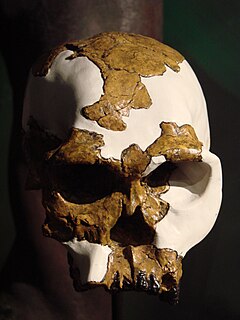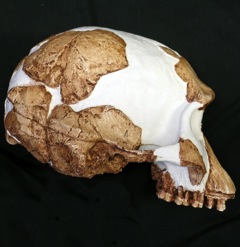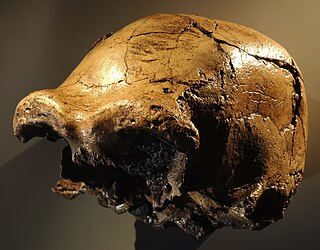
Homo habilis is an extinct species of archaic human from the Early Pleistocene of East and South Africa about 2.31 million years ago to 1.65 million years ago (mya). Upon species description in 1964, H. habilis was highly contested, with many researchers recommending it be synonymised with Australopithecus africanus, the only other early hominin known at the time, but H. habilis received more recognition as time went on and more relevant discoveries were made. By the 1980s, H. habilis was proposed to have been a human ancestor, directly evolving into Homo erectus which directly led to modern humans. This viewpoint is now debated. Several specimens with insecure species identification were assigned to H. habilis, leading to arguments for splitting, namely into "H. rudolfensis" and "H. gautengensis" of which only the former has received wide support.

Homo ergaster is an extinct species or subspecies of archaic humans who lived in Africa in the Early Pleistocene. Whether H. ergaster constitutes a species of its own or should be subsumed into H. erectus is an ongoing and unresolved dispute within palaeoanthropology. Proponents of synonymisation typically designate H. ergaster as "African Homo erectus" or "Homo erectus ergaster". The name Homo ergaster roughly translates to "working man", a reference to the more advanced tools used by the species in comparison to those of their ancestors. The fossil range of H. ergaster mainly covers the period of 1.7 to 1.4 million years ago, though a broader time range is possible. Though fossils are known from across East and Southern Africa, most H. ergaster fossils have been found along the shores of Lake Turkana in Kenya. There are later African fossils, some younger than 1 million years ago, that indicate long-term anatomical continuity, though it is unclear if they can be formally regarded as H. ergaster specimens. As a chronospecies, H. ergaster may have persisted to as late as 600,000 years ago, when new lineages of Homo arose in Africa.

Homo rudolfensis is an extinct species of archaic human from the Early Pleistocene of East Africa about 2 million years ago (mya). Because H. rudolfensis coexisted with several other hominins, it is debated what specimens can be confidently assigned to this species beyond the lectotype skull KNM-ER 1470 and other partial skull aspects. No bodily remains are definitively assigned to H. rudolfensis. Consequently, both its generic classification and validity are debated without any wide consensus, with some recommending the species to actually belong to the genus Australopithecus as A. rudolfensis or Kenyanthropus as K. rudolfensis, or that it is synonymous with the contemporaneous and anatomically similar H. habilis.
Paleoanthropology or paleo-anthropology is a branch of paleontology and anthropology which seeks to understand the early development of anatomically modern humans, a process known as hominization, through the reconstruction of evolutionary kinship lines within the family Hominidae, working from biological evidence and cultural evidence.

Turkana Boy, also called Nariokotome Boy, is the name given to fossil KNM-WT 15000, a nearly complete skeleton of a Homo ergaster youth who lived 1.5 to 1.6 million years ago. This specimen is the most complete early hominin skeleton ever found. It was discovered in 1984 by Kamoya Kimeu on the bank of the Nariokotome River near Lake Turkana in Kenya.

Human taxonomy is the classification of the human species within zoological taxonomy. The systematic genus, Homo, is designed to include both anatomically modern humans and extinct varieties of archaic humans. Current humans have been designated as subspecies Homo sapiens sapiens, differentiated, according to some, from the direct ancestor, Homo sapiens idaltu.
Kamoya Kimeu is a Kenyan paleontologist and curator, whose contributions to the field of paleoanthropology have been recognised with the National Geographic Society's LaGorce Medal and with a honorary Doctorate of Science degree from Case Western Reserve University.

Koobi Fora refers primarily to a region around Koobi Fora Ridge, located on the eastern shore of Lake Turkana in the territory of the nomadic Gabbra people. According to the National Museums of Kenya, the name comes from the Gabbra language:
In the language of the Gabbra people who live near the site, the term Koobi Fora means a place of the commiphora and the source of myrrh...

KNM ER 1813 is a skull of the species Homo habilis. It was discovered in Koobi Fora, Kenya by Kamoya Kimeu in 1973, and is estimated to be 1.9 million years old.

KNM ER 1805 is the catalog number given to several pieces of a fossilized skull of the species Homo habilis. It was discovered in Koobi Fora, Kenya in 1974. The designation indicates specimen 1805, collected from the east shore of Lake Rudolf for the Kenya National Museums.

OH 24 is a fossilized skull of the species Homo habilis. It was discovered in Olduvai Gorge, Tanzania by Peter Nzube in 1968. The skull was found crushed almost flat and was therefore named after the famously skinny model of the time Twiggy. Estimated at about 1.8 mya, the cranium was found crushed flat and cemented together with a mass coating of limestone.

KNM ER 3733 is a fossilized hominid cranium of the extinct hominid Homo ergaster, alternatively referred to as African Homo erectus. It was discovered in 1975 in Koobi Fora, Kenya, right next to Lake Turkana, in a survey led by Richard Leakey, by a field worker called Bernard Ngeneo.
KNM ER 406 is an almost complete fossilized skull of the species Paranthropus boisei. It was discovered in Koobi Fora, Kenya by Richard Leakey and H. Mutua in 1969. This species is grouped with the Australopitecine genus, Paranthropus boisei because of the robusticity of the skull and the prominent characteristics. This species was found well preserved with a complete cranium but lacking dentition. He was known for his robust cranial features that showed the signs of adaptation of the ecological niches. The big chewing muscles attached to the sagittal crest are traits of this adaptation.

KNM ER 992 is a 1.5 million years old fossilized lower jaw discovered by Richard Leakey in 1971 at Lake Turkana, Kenya. The mandible was considered by C. Groves and V. Mazak to be the holotype specimen for Homo ergaster.

In physical anthropology, post-orbital constriction is the narrowing of the cranium (skull) just behind the eye sockets found in most non-human primates and early hominins. This constriction is very noticeable in non-human primates, slightly less so in Australopithecines, even less in Homo erectus and completely disappears in modern Homo sapiens. Post-orbital constriction index in non-human primates and hominin range in category from increased constriction, intermediate, reduced constriction and disappearance. The post-orbital constriction index is defined by either a ratio of minimum frontal breadth (MFB), behind the supraorbital torus, divided by the maximum upper facial breadth (BFM), bifrontomalare temporale, or as the maximum width behind the orbit of the skull.

Nanjing Man is a subspecies of Homo erectus found in China. Large fragments of one male and one female skull and a molar tooth of H. e. nankinensis were discovered in 1993 in the Hulu cave on the Tangshan (汤山) hills near Nanjing. The term Nanjing man is used to describe the subspecies of Homo erectus but is also used when referring to the three fossils. The specimens were found in the Hulu limestone cave at a depth of 60–97 cm by Liu Luhong, a local worker. Dating the fossils yielded an estimated age of 580,000 to 620,000 years old.
Ileret is a village in Marsabit County, Kenya. It is located in Northern Kenya, on the eastern shore of Lake Turkana, north of Sibiloi National Park and near the Ethiopian border.

Homo gautengensis is a species name proposed by anthropologist Darren Curnoe in 2010 for South African hominin fossils otherwise attributed to H. habilis, H. ergaster, or, in some cases, Australopithecus or Paranthropus. The fossils assigned to the species by Curnoe cover a vast temporal range, from about 1.8 million years ago to potentially as late as 0.8 million years ago, meaning that if the species is considered valid, H. gautengensis would be both one of the earliest and one of the longest lived species of Homo.

The Daka calvaria, otherwise known as the Dakaskull, or specimen number BOU-VP-2/66, is a Homo erectus specimen from the Daka Member of the Bouri Formation in the Middle Awash Study Area of the Ethiopian Rift Valley.

D2700, also known as Dmanisi skull 3, is one of five skulls discovered in Dmanisi, Georgia in 2001 and classified as early Homo erectus. It is an almost complete skull and is in an exceptionally good condition. It was dated stratigraphically as about 1.8 million years old.















